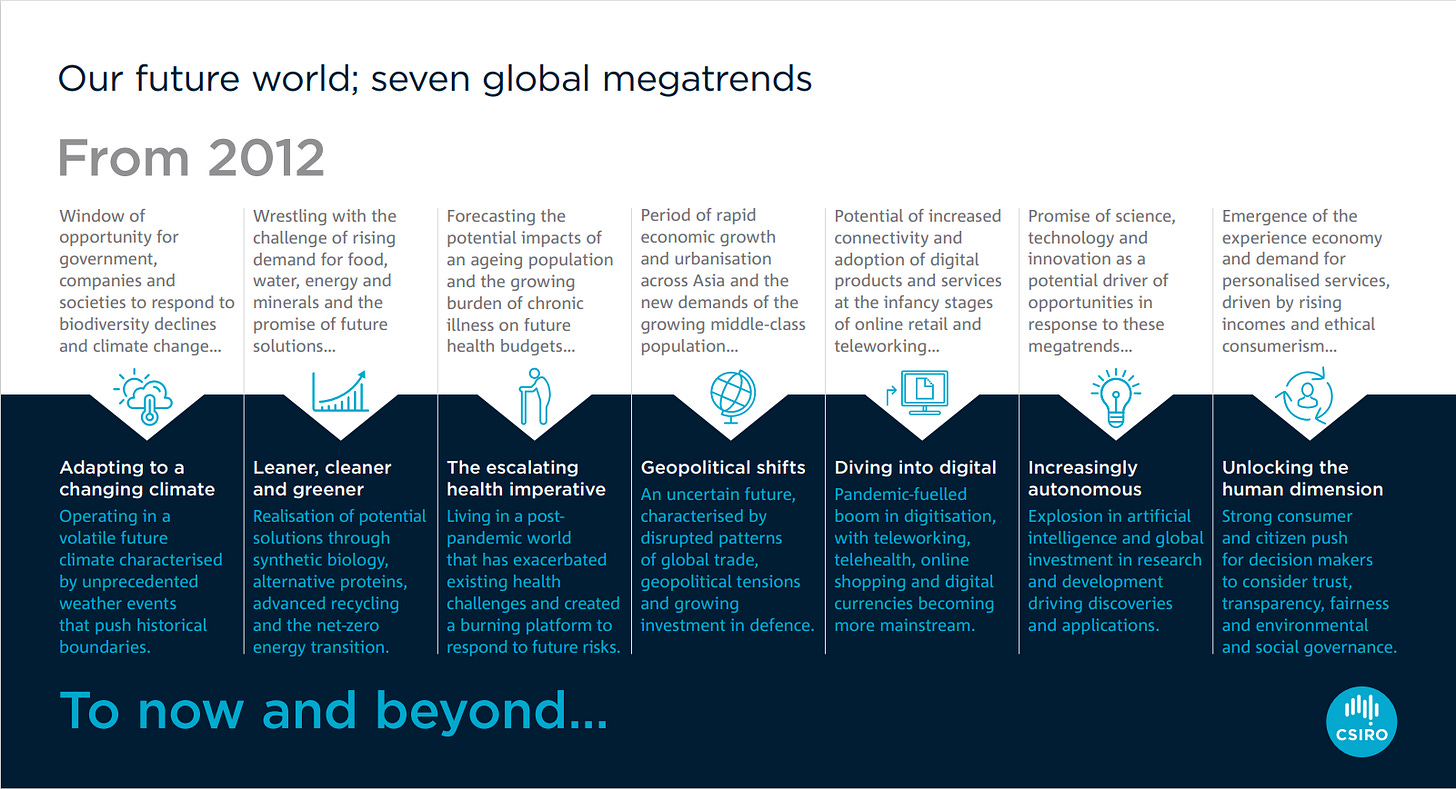July 2022 ended with the release of Our Future World [1], the second CSIRO report on “megatrends”—global changes with the potential for transformative impacts on individuals, organisations, and society.
The first “Our Future World” report in 2012 [2] identified six global megatrends, and established the format as a new channel for CSIRO’s science and technology thought leadership in Australia. The 2022 report identifies seven global megatrends, with clear connections to the 2012 megatrends, as might be expected. Climate change, health, natural resources, and Australia’s place in the global society, for example, underpin four of the megatrends now as in 2012.
Among the three remaining megatrends, digital transformation has an expanded profile in 2022, with two of the identified megatrends explicitly connected with the impacts of information and automation (where as one megatrend in 2012 was more narrowly focused on the impacts of online connectivity). And while still strongly technology-focused, there is a welcome increase in the emphasis on humans and society as integral to successful technology impacts.
The report itself is accessible, clear, concise, and peppered with over 350 references: that’s one reference in support of almost every sentence at the core of the report. Taking a digital futures perspective, most of the topics one might expect find in the report are present, including AI and machine learning, cybersecurity, automation and industry 4.0. Looking behind those trends, it’s also possible to identify a number of other threads woven through the report with direct relevance to digital futures. Four of these threads are picked up in this post: digital inclusion, digital health, digital workforces, and digital knowledge.
Digital inclusion
The report’s seventh megatrend of social change (“Unlocking the human dimension”), introduced above, reflects on both longer-term social trends, and the recent impacts of the pandemic. For example, the report highlights metrics that point to increased social cohesion in Australia through the pandemic (“Patterns of social cohesion in Australia“), bucking the global trend. At the same time, the report acknowledges the counter-context of other indicators, including increasing wealth inequality (“Patterns of wealth distribution and income inequality“) and financial housing stress (“The rising bar for the great Australian dream”). From the digital perspective, multiple trends identify the need to better connect technological change to equity and inclusion, including affordability and access to digital (“Towards increased digital inclusivity”); social media addiction (“The risk of spending too much time online”); safeguarding fairness and trust in machines, as the applications of AI continue to mushroom (“The ethics of artificial intelligence”); and the impacts of pandemic-driven changes in digital working practices on gender equity (“Gender diversity in the workplace”).
Digital health
Health is central to another one of the seven megatrends identified in the report (“The escalating health imperative“). For instance, the report touches on how the rising proportion of spending on healthcare, already in Australia above average for OECD countries, presents growing challenges as our population ages—the better our healthcare, the longer we live. Digital technologies emerge as one approach that may help tackle this quandary. For example, the report highlights increased opportunities for precision healthcare (“The promise of precision health”); telehealth (“Diving into digital”); connectivity and support for vulnerable people with disabilities and mental health conditions (“A growing chronic health burden” and “The burden of mental health”—despite the somewhat unhelpful language of encumbrance); and a wide range of other digital health initiatives accelerated by the pandemic (“Digital health is becoming mainstream“).
Digital workforce
While automation and digital technologies were set to disrupt many areas of work long before COVID (“Mass adoption of Industry 4.0 technologies”), other impacts were accelerated or even created by the changes to how we work caused by the pandemic. In particular, the report highlights the impacts of changing working patterns on our regions and cities (“The rise of the regions enabled by teleworking and online services” and “A new era for the central business district”); on the needs for new digital skills and workforce development (“Future demand for digital workers”); on growth in online commerce (“Pandemic-fuelled growth in e-commerce”); as well as of course the ongoing changes in how and where we work (“An office-less workforce?”) and who we choose to work for (“Evolving labour markets and workforce cultures”).
Digital knowledge
Finally, several of the trends identified link back to how we create and communicate knowledge, and the impacts of digital technologies on shaping those processes for better and for worse. The changing characteristics of information and misinformation flows have played a key role in our national and global responses to the pandemic, with direct social, economic, and health consequences (“An ‘infodemic’ within the pandemic and beyond”). While trust in scientists remains relatively high in Australia (”Trust in Australian institutions”), the nuance and subtlety often required to understand scientific advances is not always well-suited to today’s digital communication channels (“Communicating the complexities of science”). New ways to access and interpret knowledge about the world come in the context of global-scale changes to research and development (“The shifting centre of research and development investment” and “Uncertainty around future flows of scientific knowledge”). The report highlights that while spending on research and development is increasing (“Global investments in research and development”), Australia as a country spent less on research nationally in 2019-2020 than either of the companies Amazon or Alphabet (“Declining research and development spending intensity in Australia”).
Predicting the future is a fraught endeavour, as freely acknowledged in the report by the authors. However, it seems likely that the report’s central prediction—that the significant impacts of digital transformation seen in recent years are only the tip of the iceberg—will still hold when we come to look back on this report in 2032.
References
[1] Naughtin C, Hajkowicz S, Schleiger E, Bratanova A, Cameron A, Zamin T, Dutta A (2022) Our Future World: Global megatrends impacting the way we live over coming decades. Brisbane, Australia: CSIRO.
[2] Hajkowicz S, Cook H; Littleboy A (2012). Our Future World: Global megatrends that will change the way we live. Brisbane, Australia: CSIRO. doi:10.4225/08/584ee9706689b
















Share this post